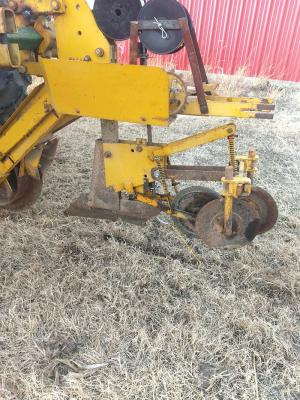2021 - Volume #45, Issue #4, Page #10
[ Sample Stories From This Issue | List of All Stories In This Issue | Print this story
| Read this issue]
Converted Planter Used To Install Dog Fence
 |
“I figured if it could place seed corn 2 in. in the ground, it could put wire down 2 in. as well,” says Jacob. “I used an old row unit from a Buffalo Till planter. In no time at all, I was laying wire.”
Jacob buys large planters and then breaks them down into 2 and 4-row, 3-pt. hitch units and resells them (Vol. 41, No. 1). He says there is a strong demand for wildlife food plot planters. The Buffalo planters are heavy, but make great no-till planters.
“To lay wire, I centered a planter unit on the mini-toolbar, removed the seed hopper and plates, and mounted a free turning wire reel,” says Jacob. “I also replaced the seed tube with a stainless steel tube similar to a fertilizer tube.”
He then secured the wire feed tube to the side of the planter unit and at the bottom, curved it backwards to where the seed would normally drop, just ahead of the closing wheels.
“I just lower the planter and start driving, I don’t even have to stake the wire,” says Jacob. “It just feeds out and into the ground. It hardly leaves any tracks in the sod.”
After laying invisible fence for his dogs, Jacob is considering laying it for a few goats. “I have quite a bit of machinery behind my shop, as well as cattle pens,” he says. “I have a hard time mowing it and keeping the trees down. My daughter is a veterinarian, and she told me about people using dog fence and collars on goats for vegetation control. The collars get pricey, but so does fencing off an area like that.”
While Jacob hasn’t tried it yet, he suspects the planter would do an equally good job laying shallow subsurface irrigation tape. “You could lay it right over root crops,” he says.
What Jacob really likes is the ease of converting the unit back to planting seeds. “When I am done with the underground fence, I’ll pull the stainless steel tube and replace the seed tube, seed drive gear and hopper, add the other row unit and sell it.”
Jacob says he can sell a 2-row unit for $1,500 or more. “It can take some work when they’ve been sitting in a fencerow for years, but I’ve sold them for as much as $4,500 with fertilizer units on them,” he adds.
Contact: FARM SHOW Followup, Terry Jacob, 9317 S.W. 72nd, Sedgwick, Kan. 67135 (ph 316 393-7731; ruth1110@kanokla.net).

Click here to download page story appeared in.

Click here to read entire issue
To read the rest of this story, download this issue below or click here to register with your account number.




